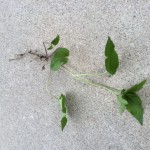

A quick and easy way to brighten up decks, roof top gardens etc..
is with planters. Picking out a great looking pot is the first step. Clay planters tend to have a higher end look to them, imitation plastic ones can be pleasing if chosen correctly.
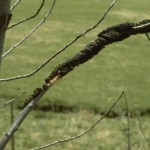
Black knot (Dibotryon morbosum) is a fungal infection that is
common to the Prunus genus. This genus includes Mayday Trees and Schubert Chokecherries. Black knot disease was first described in 1821 in Pennsylvania. During the 1880′s black knot was the most destructive disease of tart cherries and plums in the United States. The disease was later spread to Canada. This disease is not as destructive as it was historically, but with several wet Calgary spring times and over irrigation the disease is making a return.
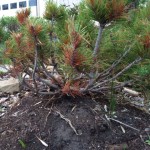 Whether it is planting summer annuals or costly trees the depth of your roots makes a significant difference to the plants health and longevity. As a general rule the roots should be completely buried with the plants or tree stem/trunk exposed. Quite simply the plant should be level with the ground. If plant roots are exposed they will desiccate rapidily causing growth retardation or death. Winter kill is often caused by this excessive drying of the roots. If the stem or trunk is buried, rot can occur. Branches growing directly in soil can cause disease problems.
Whether it is planting summer annuals or costly trees the depth of your roots makes a significant difference to the plants health and longevity. As a general rule the roots should be completely buried with the plants or tree stem/trunk exposed. Quite simply the plant should be level with the ground. If plant roots are exposed they will desiccate rapidily causing growth retardation or death. Winter kill is often caused by this excessive drying of the roots. If the stem or trunk is buried, rot can occur. Branches growing directly in soil can cause disease problems.
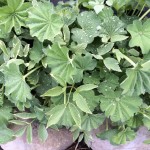
Shady, damp areas are often a difficult place to maintain a garden. Coniferous (cone bearing trees) tend to create a rather acid soil
environment making plant growth difficult. The soil can be amended with calcium sources. It is better to use decorative mulch, rather than plants under trees. Mulch will prevent root damage to the trees. Under deciduous trees (broad leaf trees) it is not necessarily a desirable place to plant, because of potential root damage to the trees. When you go outside of the drip line (the edge of the branches) the roots are deeper and the soil is less acidic making planting desirable.
Often by looking at a plants foliage, you can tell if it will do well in a damp shady area. Shade plants have large leaves to maximize photosynthesis.
Lily of the valley – Convallaria majalis
Hosta lily’s – Hosta crispula/elata
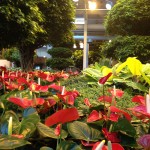 Gardeners look forward to the bright, instant flash of colour annual flowering plants bring to their planters and flower beds. The number of cultivars available to the home or commercial gardener is truly abundant.
Gardeners look forward to the bright, instant flash of colour annual flowering plants bring to their planters and flower beds. The number of cultivars available to the home or commercial gardener is truly abundant.
To ensure the success of your newly purchased planting materials, it is important to keep them well watered before and after planting. A cool overcast day is ideal, when transferring young ornamentals to their new environment. A hot sunny day will cause additional shock to transplants, leaving plants wilted or scorched .
Soil should be tilled up and moist prior to planting. If the soil is excessively heavy or sandy, compost or peat can be incorporated. These pre-planting additions will aid in the development of new roots. Slow release granular fertilizers can be added at this time.
When it comes time to remove plants from their cell packs, loosen or slightly score the roots, this will stimulate growth and spread. If roots are not stimulated they will grow and continue to circle them selves causing reduced over all vigour.
Transplants should be planted level with the soil. If annuals are planted too deep rot can occur and if the root ball is left slightly exposed then plant will dry out excessively. The soil should be lightly tamped and watered throughly.
Water soluble fertilizers can be added after planting, if pre-planting fertilizers have not been previously added. Fertilizers for flowering plants should be high in phosphorus, this is represented by the middle number in a fertilizer ratio. These ratios are always printed on the packaging of any fertilizer.
The single most important factor to ensure the survival of annual plantings is to keep them well watered during their initial establishment. Annual transplants have to be watered daily unless it is raining adequately.
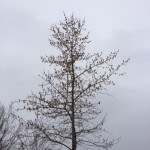
It is a general rule to prune trees while they are dormant to minimize damage and stimulate new growth.
Fruit bearing trees are pruned during dormancy to reduce crop quantity, but increase the fruits quality. This timing will also aid in new bud formation the following year.
Deciduous trees thrive with a late winter early spring pruning.
]]> on the task of building your own bed, you should keep in mind to have at least 12” of top soil. This will be optimal for your plants root systems to grow and flourish. Be sure you use “Garden Mix” and not just loam to help your plants the proper nutrients for the transition from pots to the ground. Raised beds are recommended because they look beautiful and a good edger will help prevent annoying grass from growing in your beds.
]]>
on the task of building your own bed, you should keep in mind to have at least 12” of top soil. This will be optimal for your plants root systems to grow and flourish. Be sure you use “Garden Mix” and not just loam to help your plants the proper nutrients for the transition from pots to the ground. Raised beds are recommended because they look beautiful and a good edger will help prevent annoying grass from growing in your beds.
]]>
How often you fertilize a home lawn depends on your soil type. Most of Calgary has very rich clay soil. Clay based soils hold nutrients very well, unlike sandy soils that naturally leach fertilizers. Properties in the river valleys tend to have sandy soils.
Add a cool day and irrigation to these application dates and success shall be yours.
By Jacquie Lautermilch
]]> There are a lot of variables when it comes to weed growth but we will start simple. In the spring, around the same time as your first mow, you should start off by feeding your grass
There are a lot of variables when it comes to weed growth but we will start simple. In the spring, around the same time as your first mow, you should start off by feeding your grass
with a good fertilizer like Scotts Turf Builder Lawn Fertilizer. (be sure to mow higher in the spring to encourage healthy roots I would recommend over 2″) If your grass is healthy and well fed, then weeds will have a harder time taking over. Once you do see a weed pop up, you may want to spot-kill them with something like Ortho Weed-B-Gon MAX® Weed Killer For Lawns. And if they have already become a big problem for you, you could try something like Scotts® Turf Builder® Weed & Feed. Be sure you calibrate your fertilizer spreader correctly, usually there are instructions on the back of the fertilizer bag. Don’t forget to give your grass a good watering after to prevent a burnt lawn too. Watering your lawn very well 1-2 times per week will encourage lawn health and keep your weeds at bay!
]]>